wheel HYUNDAI KONA EV 2022 Owners Manual
[x] Cancel search | Manufacturer: HYUNDAI, Model Year: 2022, Model line: KONA EV, Model: HYUNDAI KONA EV 2022Pages: 548, PDF Size: 49.14 MB
Page 506 of 548
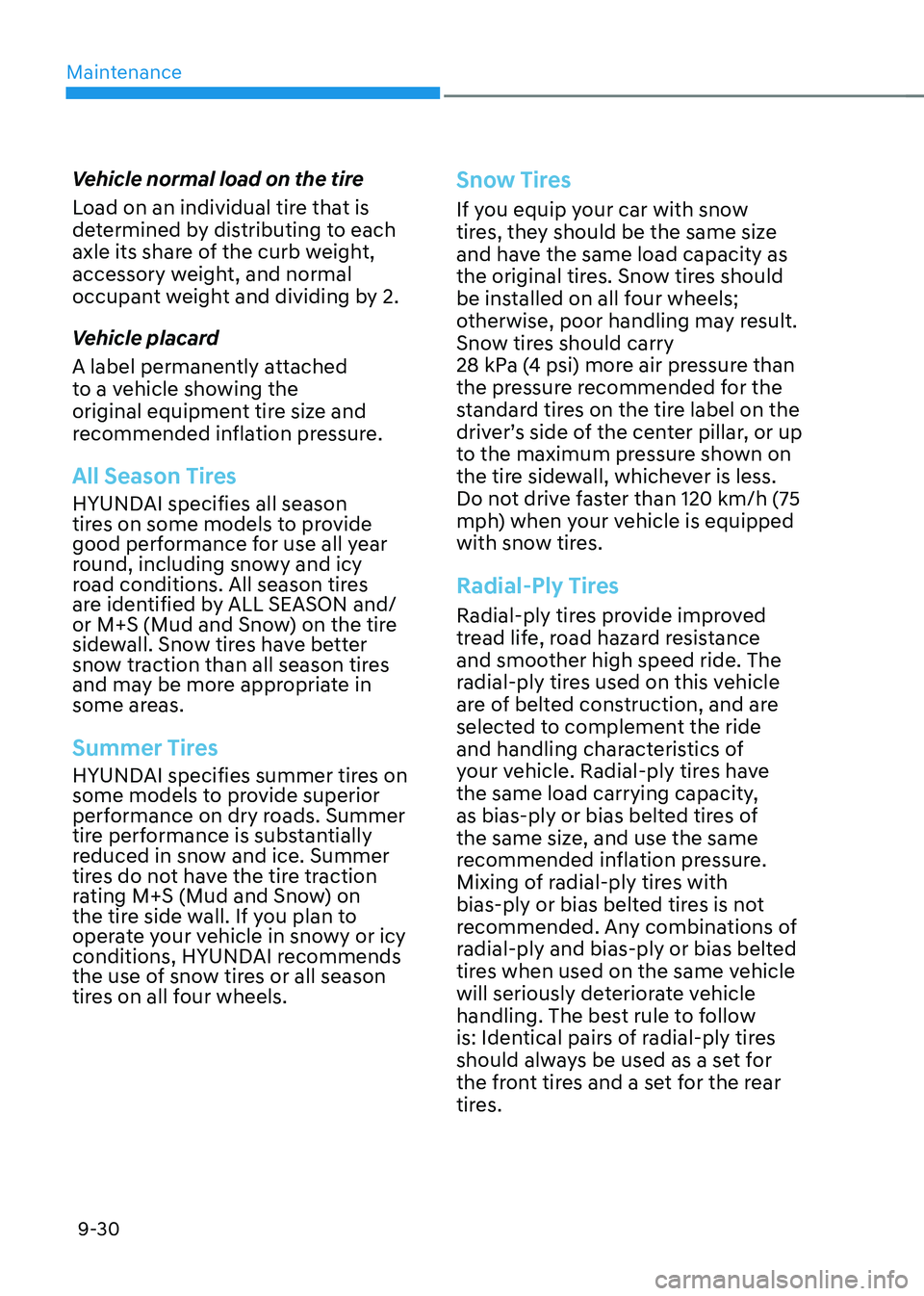
Maintenance
9-30
Vehicle normal load on the tire
Load on an individual tire that is
determined by distributing to each
axle its share of the curb weight,
accessory weight, and normal
occupant weight and dividing by 2.
Vehicle placard
A label permanently attached
to a vehicle showing the
original equipment tire size and
recommended inflation pressure.
All Season Tires
HYUNDAI specifies all season
tires on some models to provide
good performance for use all year
round, including snowy and icy
road conditions. All season tires
are identified by ALL SEASON and/
or M+S (Mud and Snow) on the tire
sidewall. Snow tires have better
snow traction than all season tires
and may be more appropriate in
some areas.
Summer Tires
HYUNDAI specifies summer tires on
some models to provide superior
performance on dry roads. Summer
tire performance is substantially
reduced in snow and ice. Summer
tires do not have the tire traction
rating M+S (Mud and Snow) on
the tire side wall. If you plan to
operate your vehicle in snowy or icy
conditions, HYUNDAI recommends
the use of snow tires or all season
tires on all four wheels.
Snow Tires
If you equip your car with snow
tires, they should be the same size
and have the same load capacity as
the original tires. Snow tires should
be installed on all four wheels;
otherwise, poor handling may result.
Snow tires should carry
28 kPa (4 psi) more air pressure than
the pressure recommended for the
standard tires on the tire label on the
driver’s side of the center pillar, or up
to the maximum pressure shown on
the tire sidewall, whichever is less.
Do not drive faster than 120 km/h (75
mph) when your vehicle is equipped
with snow tires.
Radial-Ply Tires
Radial-ply tires provide improved
tread life, road hazard resistance
and smoother high speed ride. The
radial-ply tires used on this vehicle
are of belted construction, and are
selected to complement the ride
and handling characteristics of
your vehicle. Radial-ply tires have
the same load carrying capacity,
as bias-ply or bias belted tires of
the same size, and use the same
recommended inflation pressure.
Mixing of radial-ply tires with
bias-ply or bias belted tires is not
recommended. Any combinations of
radial-ply and bias-ply or bias belted
tires when used on the same vehicle
will seriously deteriorate vehicle
handling. The best rule to follow
is: Identical pairs of radial-ply tires
should always be used as a set for
the front tires and a set for the rear
tires.
Page 507 of 548
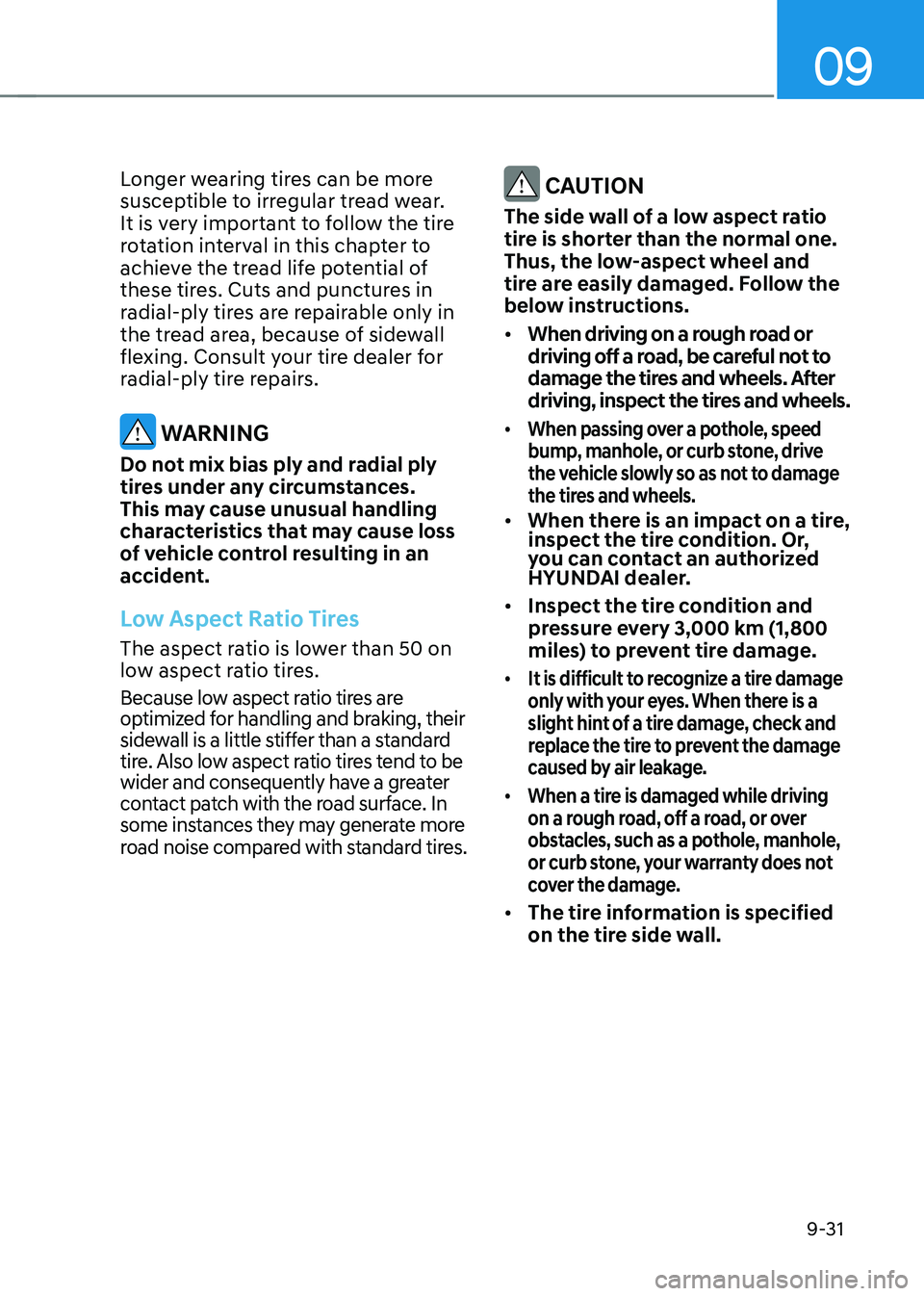
09
9-31
Longer wearing tires can be more
susceptible to irregular tread wear.
It is very important to follow the tire
rotation interval in this chapter to
achieve the tread life potential of
these tires. Cuts and punctures in
radial-ply tires are repairable only in
the tread area, because of sidewall
flexing. Consult your tire dealer for
radial-ply tire repairs.
WARNING
Do not mix bias ply and radial ply
tires under any circumstances.
This may cause unusual handling
characteristics that may cause loss
of vehicle control resulting in an
accident.
Low Aspect Ratio Tires
The aspect ratio is lower than 50 on
low aspect ratio tires.
Because low aspect ratio tires are
optimized for handling and braking, their
sidewall is a little stiffer than a standard
tire. Also low aspect ratio tires tend to be
wider and consequently have a greater
contact patch with the road surface. In
some instances they may generate more
road noise compared with standard tires.
CAUTION
The side wall of a low aspect ratio
tire is shorter than the normal one.
Thus, the low-aspect wheel and
tire are easily damaged. Follow the
below instructions. • When driving on a rough road or
driving off a road, be careful not to
damage the tires and wheels. After
driving, inspect the tires and wheels.
• When passing over a pothole, speed
bump, manhole, or curb stone, drive
the vehicle slowly so as not to damage
the tires and wheels.
• When there is an impact on a tire,
inspect the tire condition. Or,
you can contact an authorized
HYUNDAI dealer.
• Inspect the tire condition and
pressure every 3,000 km (1,800
miles) to prevent tire damage.
• It is difficult to recognize a tire damage
only with your eyes. When there is a
slight hint of a tire damage, check and
replace the tire to prevent the damage
caused by air leakage.
• When a tire is damaged while driving
on a rough road, off a road, or over
obstacles, such as a pothole, manhole,
or curb stone, your warranty does not
cover the damage.
• The tire information is specified
on the tire side wall.
Page 531 of 548
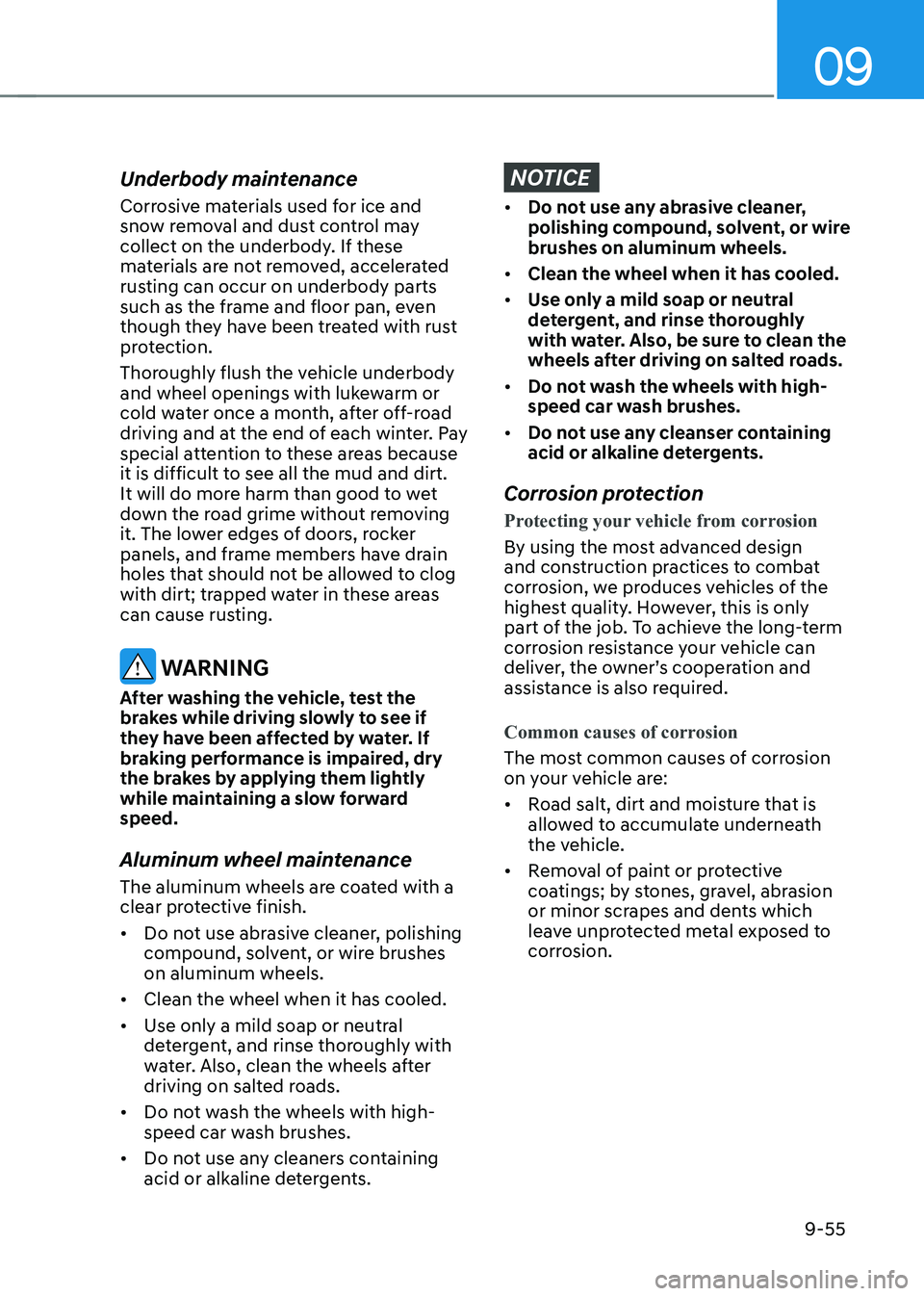
09
9-55
Underbody maintenance
Corrosive materials used for ice and
snow removal and dust control may
collect on the underbody. If these
materials are not removed, accelerated
rusting can occur on underbody parts
such as the frame and floor pan, even
though they have been treated with rust
protection.
Thoroughly flush the vehicle underbody
and wheel openings with lukewarm or
cold water once a month, after off-road
driving and at the end of each winter. pay
special attention to these areas because
it is difficult to see all the mud and dirt.
It will do more harm than good to wet
down the road grime without removing
it. The lower edges of doors, rocker
panels, and frame members have drain
holes that should not be allowed to clog
with dirt; trapped water in these areas
can cause rusting.
WARNING
After washing the vehicle, test the
brakes while driving slowly to see if
they have been affected by water. If
braking performance is impaired, dry
the brakes by applying them lightly
while maintaining a slow forward speed.
Aluminum wheel maintenance
The aluminum wheels are coated with a
clear protective finish. • Do not use abrasive cleaner, polishing
compound, solvent, or wire brushes on aluminum wheels.
• Clean the wheel when it has cooled.
• Use only a mild soap or neutral
detergent, and rinse thoroughly with
water. Also, clean the wheels after
driving on salted roads.
• Do not wash the wheels with high-
speed car wash brushes.
• Do not use any cleaners containing
acid or alkaline detergents.
NOTICE
• Do not use any abrasive cleaner,
polishing compound, solvent, or wire brushes on aluminum wheels.
• Clean the wheel when it has cooled.
• Use only a mild soap or neutral
detergent, and rinse thoroughly
with water. Also, be sure to clean the
wheels after driving on salted roads.
• Do not wash the wheels with high-
speed car wash brushes.
• Do not use any cleanser containing
acid or alkaline detergents.
Corrosion protection
Protecting your vehicle from corrosion
By using the most advanced design
and construction practices to combat
corrosion, we produces vehicles of the
highest quality. However, this is only
part of the job. To achieve the long-term
corrosion resistance your vehicle can
deliver, the owner’s cooperation and
assistance is also required.
Common causes of corrosion
The most common causes of corrosion
on your vehicle are: • Road salt, dirt and moisture that is
allowed to accumulate underneath
the vehicle.
• Removal of paint or protective
coatings; by stones, gravel, abrasion
or minor scrapes and dents which
leave unprotected metal exposed to
corrosion.
Page 533 of 548
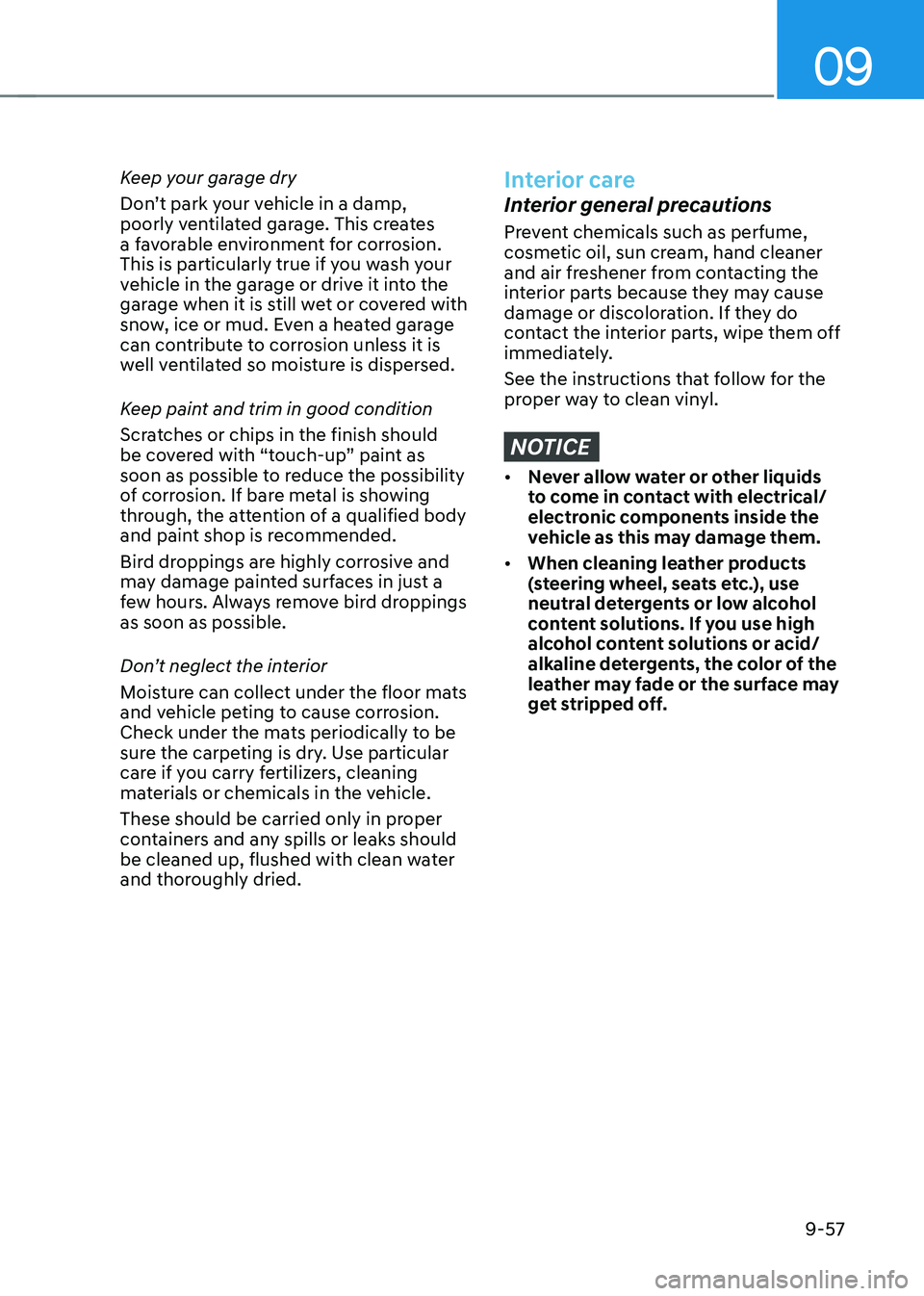
09
9-57
Keep your garage dry
Don’t park your vehicle in a damp,
poorly ventilated garage. This creates
a favorable environment for corrosion.
This is particularly true if you wash your
vehicle in the garage or drive it into the
garage when it is still wet or covered with
snow, ice or mud. Even a heated garage
can contribute to corrosion unless it is
well ventilated so moisture is dispersed.
Keep paint and trim in good condition
Scratches or chips in the finish should
be covered with “touch-up” paint as
soon as possible to reduce the possibility
of corrosion. If bare metal is showing
through, the attention of a qualified body
and paint shop is recommended.
Bird droppings are highly corrosive and
may damage painted surfaces in just a
few hours. Always remove bird droppings as soon as possible.
Don’t neglect the interior
Moisture can collect under the floor mats
and vehicle peting to cause corrosion.
Check under the mats periodically to be
sure the carpeting is dry. Use particular
care if you carry fertilizers, cleaning
materials or chemicals in the vehicle.
These should be carried only in proper
containers and any spills or leaks should
be cleaned up, flushed with clean water
and thoroughly dried.
Interior care
Interior general precautions
prevent chemicals such as perfume,
cosmetic oil, sun cream, hand cleaner
and air freshener from contacting the
interior parts because they may cause
damage or discoloration. If they do
contact the interior parts, wipe them off
immediately.
See the instructions that follow for the
proper way to clean vinyl.
NOTICE
•
Never allow water or other liquids
to come in contact with electrical/
electronic components inside the
vehicle as this may damage them.
• When cleaning leather products
(steering wheel, seats etc.), use
neutral detergents or low alcohol
content solutions. If you use high
alcohol content solutions or acid/
alkaline detergents, the color of the
leather may fade or the surface may
get stripped off.
Page 541 of 548
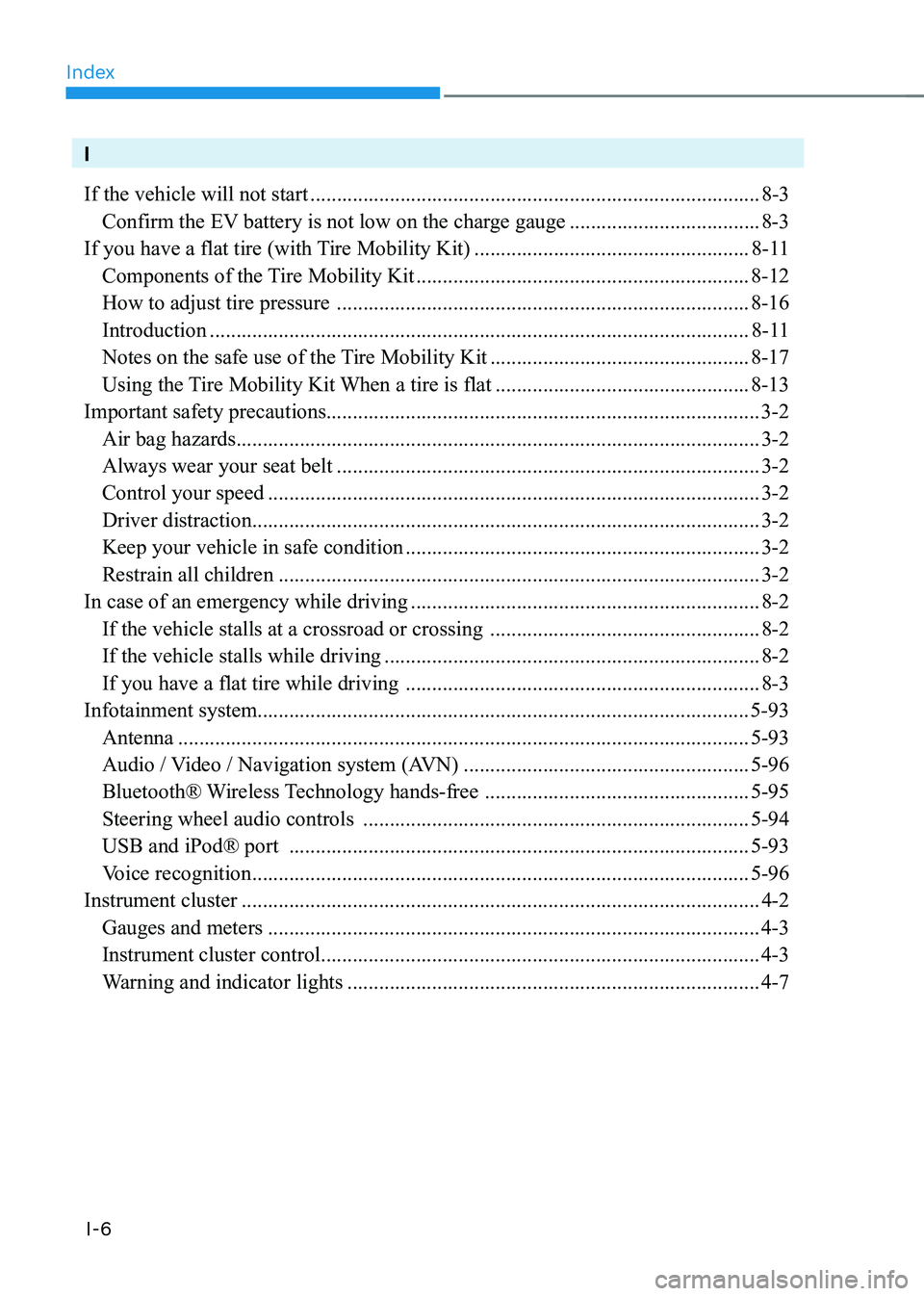
Index
I-6
I If the vehicle will not start ..................................................................................... 8-3
Confirm the EV battery is not low on the charge gauge ....................................8-3
If you have a flat tire (with Tire Mobility Kit) ....................................................8-11
Components of the Tire Mobility Kit ............................................................... 8-12
How to adjust tire pressure .............................................................................. 8-16
Introduction ...................................................................................................... 8-11
Notes on the safe use of the Tire Mobility Kit .................................................8-17
Using the Tire Mobility Kit When a tire is flat ................................................8-13
Important safety precautions.................................................................................. 3-2
Air bag hazards ................................................................................................... 3-2
Always wear your seat belt ................................................................................ 3-2
Control your speed ............................................................................................. 3-2
Driver distraction ................................................................................................ 3-2
Keep your vehicle in safe condition ................................................................... 3-2
Restrain all children ........................................................................................... 3-2
In case of an emergency while driving .................................................................. 8-2
If the vehicle stalls at a crossroad or crossing ...................................................8-2
If the vehicle stalls while driving ....................................................................... 8-2
If you have a flat tire while driving ................................................................... 8-3
Infotainment system............................................................................................. 5-93 Antenna ............................................................................................................ 5-93
Audio / Video / Navigation system (AVN) ......................................................5-96
Bluetooth® Wireless Technology hands-free ..................................................5-95
Steering wheel audio controls ......................................................................... 5-94
USB and iPod® port ....................................................................................... 5-93
Voice recognition .............................................................................................. 5-96
Instrument cluster .................................................................................................. 4-2
Gauges and meters ............................................................................................. 4-3
Instrument cluster control ................................................................................... 4-3
Warning and indicator lights .............................................................................. 4-7
Page 545 of 548
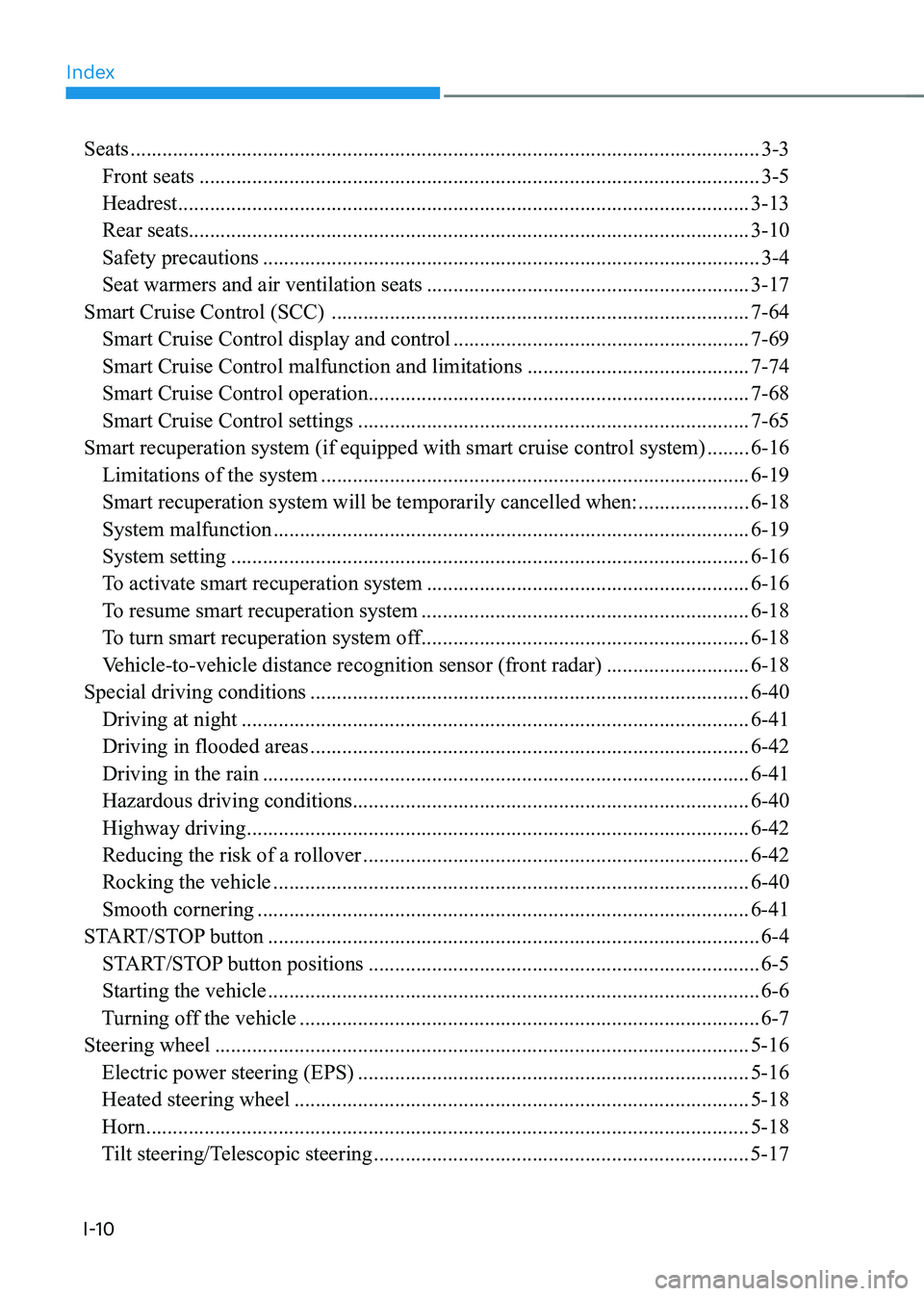
Index
I-10Seats
....................................................................................................................... 3-3
Front seats .......................................................................................................... 3-5
Headrest ............................................................................................................ 3-13
Rear seats .......................................................................................................... 3-10
Safety precautions .............................................................................................. 3-4
Seat warmers and air ventilation seats .............................................................3-17
Smart Cruise Control (SCC) ............................................................................... 7-64
Smart Cruise Control display and control ........................................................7-69
Smart Cruise Control malfunction and limitations ..........................................7-74
Smart Cruise Control operation ........................................................................ 7-68
Smart Cruise Control settings .......................................................................... 7-65
Smart recuperation system (if equipped with smart cruise control system) ........6-16
Limitations of the system ................................................................................. 6-19
Smart recuperation system will be temporarily cancelled when: .....................6-18
System malfunction .......................................................................................... 6-19
System setting .................................................................................................. 6-16
To activate smart recuperation system .............................................................6-16
To resume smart recuperation system ..............................................................6-18
To turn smart recuperation system off ..............................................................6-18
Vehicle-to-vehicle distance recognition sensor (front radar) ...........................6-18
Special driving conditions ................................................................................... 6-40
Driving at night ................................................................................................ 6-41
Driving in flooded areas ................................................................................... 6-42
Driving in the rain ............................................................................................ 6-41
Hazardous driving conditions ........................................................................... 6-40
Highway driving ............................................................................................... 6-42
Reducing the risk of a rollover ......................................................................... 6-42
Rocking the vehicle .......................................................................................... 6-40
Smooth cornering ............................................................................................. 6-41
START/STOP button ............................................................................................. 6-4
START/STOP button positions .......................................................................... 6-5
Starting the vehicle ............................................................................................. 6-6
Turning off the vehicle ....................................................................................... 6-7
Steering wheel ..................................................................................................... 5-16
Electric power steering (EPS) .......................................................................... 5-16
Heated steering wheel ...................................................................................... 5-18
Horn .................................................................................................................. 5-18
Tilt steering/Telescopic steering ....................................................................... 5-17
Page 546 of 548
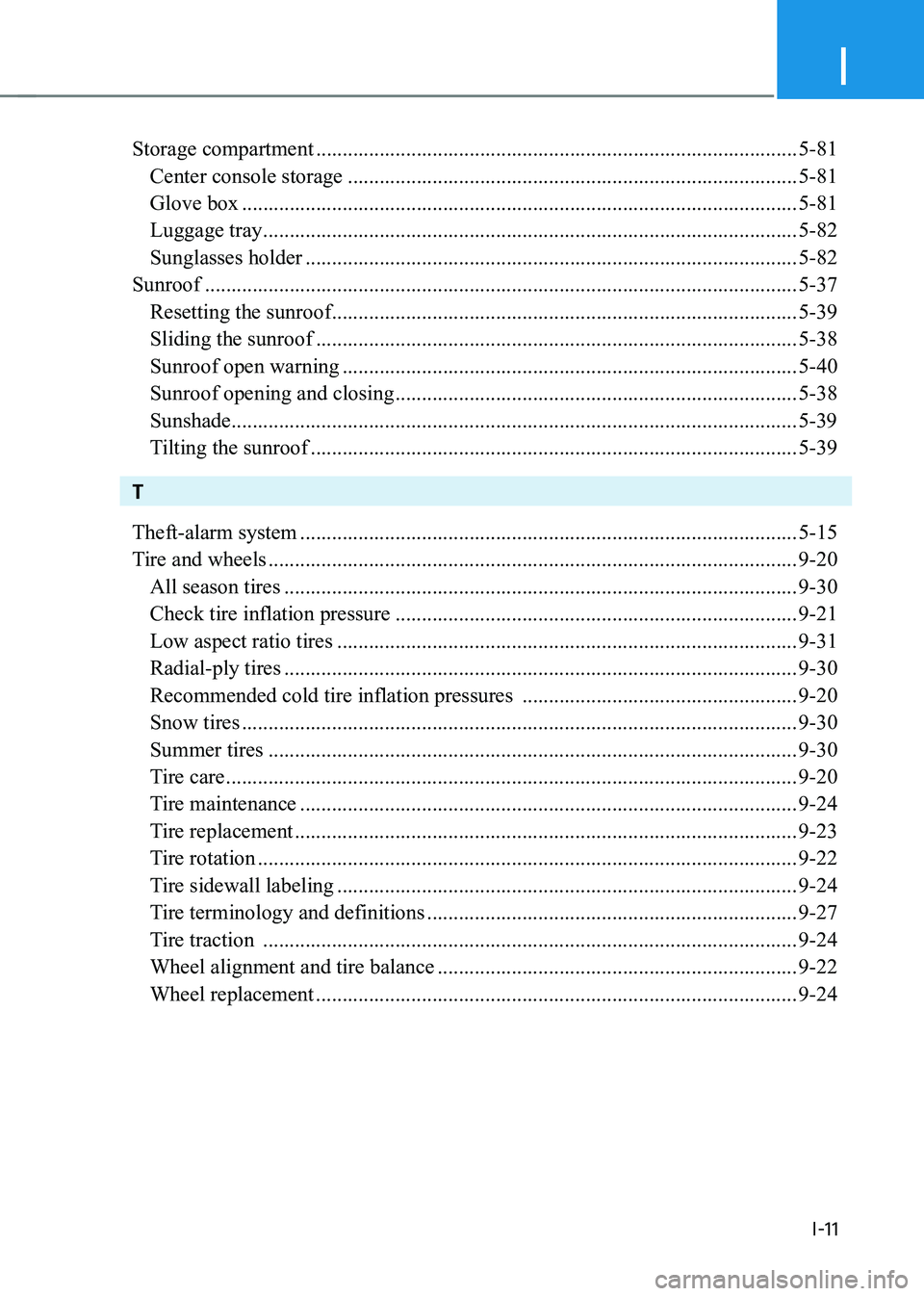
I
I-11
Storage compartment ........................................................................................... 5-81
Center console storage ..................................................................................... 5-81
Glove box ......................................................................................................... 5-81
Luggage tray ..................................................................................................... 5-82
Sunglasses holder ............................................................................................. 5-82
Sunroof ................................................................................................................ 5-37
Resetting the sunroof ........................................................................................ 5-39
Sliding the sunroof ........................................................................................... 5-38
Sunroof open warning ...................................................................................... 5-40
Sunroof opening and closing ............................................................................ 5-38
Sunshade ........................................................................................................... 5-39
Tilting the sunroof ............................................................................................ 5-39
T Theft-alarm system .............................................................................................. 5-15
Tire and wheels .................................................................................................... 9-20
All season tires ................................................................................................. 9-30
Check tire inflation pressure ............................................................................ 9-21
Low aspect ratio tires ....................................................................................... 9-31
Radial-ply tires ................................................................................................. 9-30
Recommended cold tire inflation pressures ....................................................9-20
Snow tires ......................................................................................................... 9-30
Summer tires .................................................................................................... 9-30
Tire care ............................................................................................................ 9-20
Tire maintenance .............................................................................................. 9-24
Tire replacement ............................................................................................... 9-23
Tire rotation ...................................................................................................... 9-22
Tire sidewall labeling ....................................................................................... 9-24
Tire terminology and definitions ...................................................................... 9-27
Tire traction ..................................................................................................... 9-24
Wheel alignment and tire balance .................................................................... 9-22
Wheel replacement ........................................................................................... 9-24
Page 547 of 548
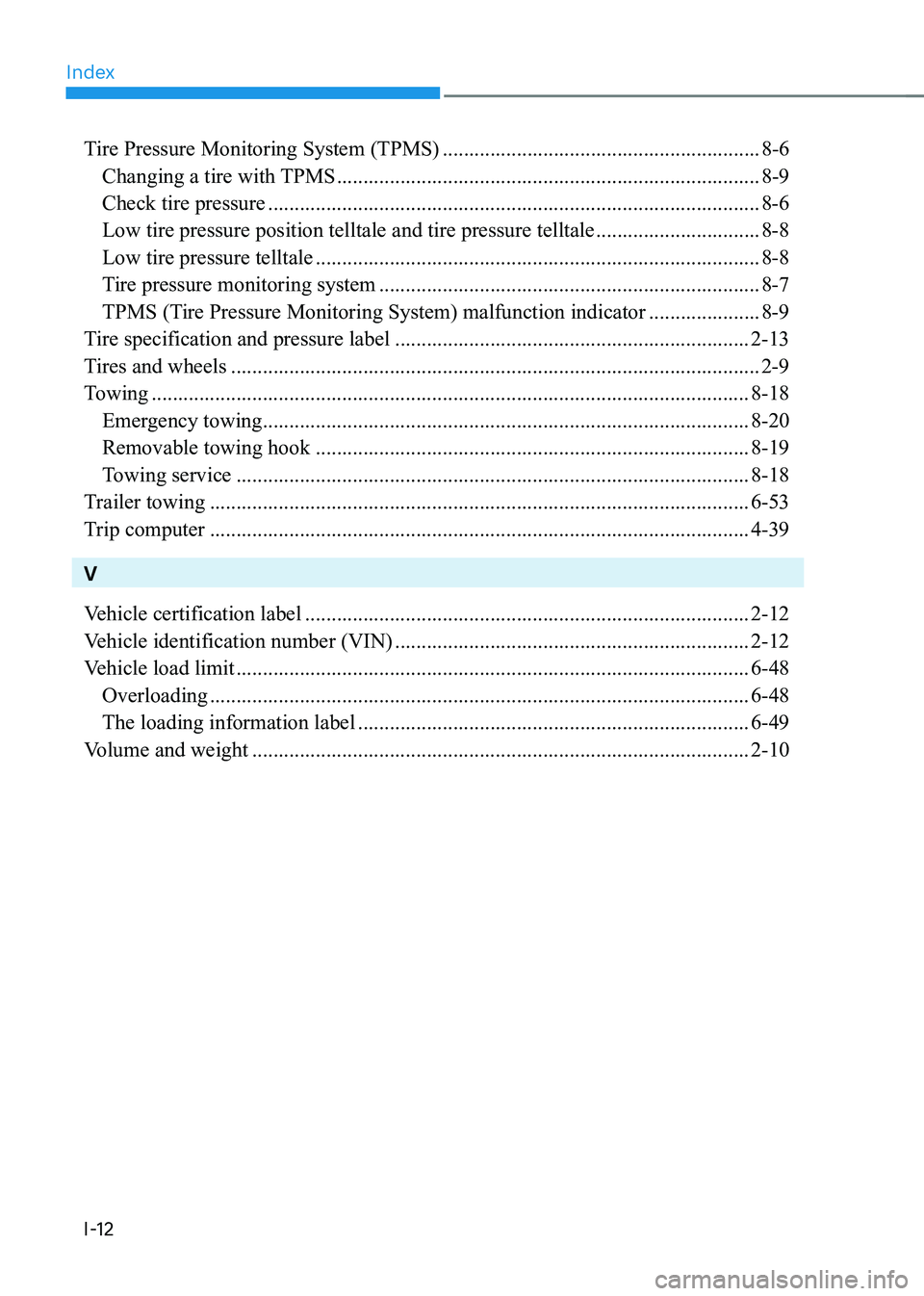
Index
I-12
Tire Pressure Monitoring System (TPMS) ............................................................8-6
Changing a tire with TPMS ................................................................................ 8-9
Check tire pressure ............................................................................................. 8-6
Low tire pressure position telltale and tire pressure telltale ...............................8-8
Low tire pressure telltale .................................................................................... 8-8
Tire pressure monitoring system ........................................................................ 8-7
TPMS (Tire Pressure Monitoring System) malfunction indicator .....................8-9
Tire specification and pressure label ................................................................... 2-13
Tires and wheels .................................................................................................... 2-9
Towing ................................................................................................................. 8-18
Emergency towing ............................................................................................ 8-20
Removable towing hook .................................................................................. 8-19
Towing service ................................................................................................. 8-18
Trailer towing ...................................................................................................... 6-53
Trip computer ...................................................................................................... 4-39
V
Vehicle certification label .................................................................................... 2-12
Vehicle identification number (VIN) ................................................................... 2-12
Vehicle load limit ................................................................................................. 6-48
Overloading ...................................................................................................... 6-48
The loading information label .......................................................................... 6-49
Volume and weight .............................................................................................. 2-10